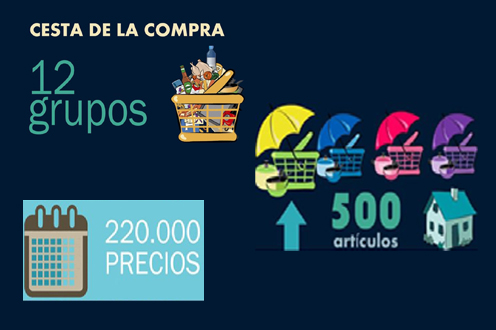This acceleration is mainly due to the evolution of energy product prices and, in particular, motor and heating fuel prices. For 2016 as a whole, average inflation was negative once again for the third year running (-0.2%), bringing about new gains in the purchasing power of salaries and pensions.
Energy product prices grew in December by 5.3% year-on-year, after the 0.5% decrease recorded in November. This increase is mainly due to the performance of motor and heating fuels, where prices grew by seven points from -1% to 6% and, to a lesser extent, due to electricity prices, which accelerated by 3.1 points to 3.7%.
Food price inflation in December stood at 0.8%, four tenths higher than in the previous month, due to an acceleration of unprocessed food prices of one and a half points to 2.1%. This was mainly due to higher pulse and fresh vegetable prices, which went from shrinking by 1.1% in November to increasing by 7.7% in December. Processed food prices decelerated slightly by one tenth to 0.2% year-on-year.
Core inflation (which excludes the most volatile elements of CPI, fresh food and energy) increased by two tenths in December to 1%, due to rising prices of services, up by four tenths to 1.6%. The rise in processed food prices slowed (0.2%, versus 0.3% in November), while non-energy industrial goods (NEIG) prices continued to rise at the same annual growth rate of 0.6% recorded in the two previous months.
In month-on-month terms, the CPI rose in December by 0.6%, versus a 0.3% decrease in the same month of 2015. By component, energy product prices grew by 3.6% after falling by 2.2% one year previously, services prices increase by 0.6%, three tenths more than in the same month of 2015, NEIG prices shrank by 0.6%, the same as in December the previous year, and food prices grew by 0.4%, versus unchanging prices one year previously.
In the food group, prices of unprocessed food in December 2016 posted a month-on-month growth rate of 1.4%, one and a half points higher than the figure for the same month in 2015, while processed food prices stabilised, compared with the 0.1% rise one year previously. Among unprocessed foods we should note the significant increase of pulse and fresh vegetable prices, 7.4% month-on-month, after a 1.4% drop in December 2015.
The year-on-year CPI grew in December 2016 in all autonomous regions. The greatest increases were posted by Castile-La Mancha (1.1 points, to 1.6%), La Rioja (1.1 points, to 1.5%), and the Region of Murcia (also 1.1 points, to 1.6%). The lowest increase (five tenths) was recorded by the Canary Islands, with an inflation rate of 1.3%.
The INE has also published the harmonised CPI (HCPI) for December, the year-on-year rate of change being 1.4%, nine tenths higher than in November. This rate is three tenths higher than the advance figure announced by Eurostat for the whole of the Eurozone (1.1%, versus 0.6% in the previous month), resulting in Spain having an unfavourable inflation differential with the Eurozone of three tenths, after the favourable differential in November (plus one tenth).
In short, the year-on-year CPI growth rate in December stood at 1.6%, nine tenths higher than last month's figure. This increase was to a large extent due to the evolution of energy product prices and, in particular, of motor and heating fuels. The year 2016 closed with a negative average CPI (-0.2%) which for the third year running has brought about gains in the purchasing power of salaries and pensions.





